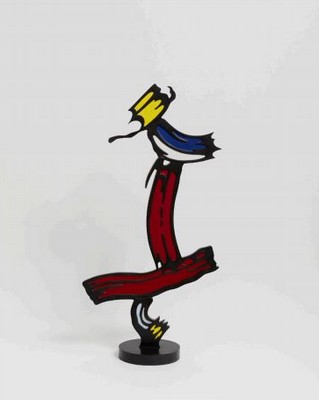Roy Lichtenstein
Pace Gallery, Palm Beach
March 18 – April 11, 2021
Brushstroke (Tuten 23), 1982
© Roy Lichtenstein, courtesy Pace Gallery and Castelli Gallery
Pace Gallery presents a solo exhibition of ten works by Roy Lichtenstein at the gallery’s seasonal location in Palm Beach, FL. Bringing together a selection of rarely seen works, this presentation features collage, drawing, painting, and sculpture from the 1970s and ‘80s, in particular showcasing Roy Lichtenstein’s return to the iconic theme of the brushstroke across a range of different media.
Borrowing from the signs and symbols of mass culture while mining images from media, advertisements, and commercial illustrations, Roy Lichtenstein developed a singular Pop idiom that playfully challenged the boundaries of “high art” and “low culture.” Over the course of a five-decade career, Roy Lichtenstein’s bold and graphic work was characterized by a probing investigation into the nature of art itself. Rendered in a striking, high-impact style achieved through the use of his signature Ben-Day dot patterning, Roy Lichtenstein’s work challenged notions of visual perception, compositional illusion, and modes of representation. An antidote to the spontaneity of the artist’s hand, his disciplined and controlled use of line imitated the mechanical reproduction and cool artifice of mass-produced imagery.
Roy Lichtenstein first explored the theme of the brushstroke in the 1960s. An abstracted gestural brushstroke first appears as an isolated visual subject in a series of paintings created between 1965 and 1966, after which it became one of the most significant and recurring motifs in his prolific career. These early paintings appropriated the motif from a 1964 comic book story by Dick Giordano, which parodied the legacy of Abstract Expressionism’s heroic and explosive marks, celebrated in the canvases of New York School artists such as Jackson Pollock, Franz Kline, and Willem de Kooning. In the late 1970s and early 1980s, Roy Lichtenstein returned to the motif of the brushstroke, reinvigorating it by liberating it from the canvas and capturing the gesture of the brushstroke as a three-dimensional form cast in bronze.
Energetic and buoyant yet weighted and bound by gravity, Brushstroke (Tuten 23) (1982) ascends vertically, a precarious stack of teetering brushstrokes in red, yellow, white, and blue. Heavy black outlines suggest a fictive dimensionality and viscosity to the otherwise flattened and frozen brushstrokes. In a series of Brushstroke Head sculptures and drawings from 1986 and 1987, Roy Lichtenstein takes the theme further and reinvents it as the building block for a loose kind of figuration, where the outlines of the brushstroke evoke the contours of a head and a field of raised red Ben-Day dots on its surface become the freckled face of the artist’s comic book heroine. A sweeping yellow stroke delineates the figure’s golden blonde hair.
Marking the culmination of Roy Lichtenstein’s tongue-in-cheek variations on the theme of the brushstroke during the 1980s, the exhibition includes Brushstroke Chair and Ottoman (1986–88), the artist’s extraordinary sculptural rendering of functional furniture made from nothing other than the undulating forms of three-dimensional brushstrokes rendered in cast and painted bronze, their torqued forms parodying the molded wood curves of mid-century design.
ROY LICHTENSTEIN (1923–1997) was a leading figure in twentieth-century American art and a pioneer of the Pop Art movement. His groundbreaking and profoundly innovative career employs parody and imitation toward critical and philosophical ends. Borrowing and reworking popular and mass-produced imagery from sources such as advertisements and comic books, Roy Lichtenstein developed a signature style that utilized Ben-Day dots—a rigorous manual process that employed perforated templates to emulate the dot patterns used in commercial printing processes—which elevated both the content and the aesthetic of mass production to the realm of “fine art.”
Roy Lichtenstein was born in New York City and studied at New York’s Art Students League in 1940. He enrolled at Ohio State University, where he began his undergraduate studies until 1943 when he was drafted by the Army and served in Europe during World War II. Upon his return, he resumed his art studies in Ohio and received his BFA in 1946 and MFA in 1949. Roy Lichtenstein joined the faculty at Ohio State University in 1946 and taught there until 1951. In 1957, he began teaching at the State University of New York at Oswego. He accepted a professorship at Douglass College at Rutgers University in New Jersey in 1960, where he met colleague Allan Kaprow, who introduced him to many of the artists involved with Fluxus.
In 1951, Roy Lichtenstein exhibited his first solo show in New York. In 1962, he held his first solo presentation with Leo Castelli Gallery, which catapulted his career and international rise to prominence. Roy Lichtenstein moved freely, back and forth, across a disparate range of influences from comic books and mass-media imagery to subjects throughout the history of art. He engaged with dialogues of the European tradition, authoring compositions based off of the paintings of Monet, Mondrian, and Picasso, among others; he revisited major twentieth-century movements such as Cubism, Futurism, and Surrealism; and extended his curiosities beyond the Western cannon to include imagery appropriated from Chinese landscape painting.
Throughout the late 1960s Roy Lichtenstein’s work was subject to numerous museum surveys: the Pasadena Art Museum initiated a traveling retrospective in 1967; the Stedelijk Museum, Amsterdam, presented his first European retrospective in 1968; and The Solomon R. Guggenheim Museum hosted his first New York retrospective in 1969.
Roy Lichtenstein was a distinguished painter, sculpture, and printmaker. He was elected to the American Academy of Arts and Letters, New York in 1979. Two years before his death, he was awarded the National Medal of Arts in 1995.
PACE GALLERY
340 Royal Poinciana Way, Suite M333, Palm Beach, FL

